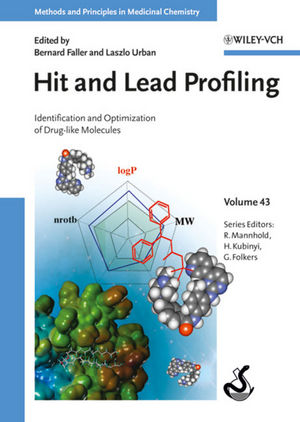Hit and Lead Profiling: Identification and Optimization of Drug-like MoleculesISBN: 978-3-527-32331-9
Hardcover
533 pages
September 2009
 |
||||||
The only reference on current methods to generate pharmacokinetic and safety profiles of drug candidates, as well as how they must be balanced against one other for the best selection of candidates for further development.
Following a brief introduction to the necessities of filtering and risk assessment of potential new drug molecules before actual drug development, the two equally important aspects of pharmacological (ADME) and safety (toxicity) profiling are covered in separate parts.
The ADME section covers the profiling of basic physicochemical parameters, such as solubility and permeability, as well as more complex traits, such as the likelihood of drug-drug interactions, metabolic clearance and protein binding properties.
The toxicology part addresses, among others, recent advances in early genetic toxicity testing, bioactivation screening, organ-specific toxicity assays for liver, heart, kidney and blood, as well as profiling for autoimmune reactions.
By addressing both drug efficiency and drug safety, this modern practical reference shows readers how each individual aspect figures in shaping the key decisions on which the entire drug development process hinges. In short, this is a complete toolbox for assessing the risk/benefit ratio for any novel compound during the early drug development stages, using both in vitro and in silico methods.
Both editors are based at one of the leading research-driven pharmaceutical companies, and the authors have been recruited from numerous other global players in the field.
Invaluable know-how for every medicinal chemist and drug developer.
Following a brief introduction to the necessities of filtering and risk assessment of potential new drug molecules before actual drug development, the two equally important aspects of pharmacological (ADME) and safety (toxicity) profiling are covered in separate parts.
The ADME section covers the profiling of basic physicochemical parameters, such as solubility and permeability, as well as more complex traits, such as the likelihood of drug-drug interactions, metabolic clearance and protein binding properties.
The toxicology part addresses, among others, recent advances in early genetic toxicity testing, bioactivation screening, organ-specific toxicity assays for liver, heart, kidney and blood, as well as profiling for autoimmune reactions.
By addressing both drug efficiency and drug safety, this modern practical reference shows readers how each individual aspect figures in shaping the key decisions on which the entire drug development process hinges. In short, this is a complete toolbox for assessing the risk/benefit ratio for any novel compound during the early drug development stages, using both in vitro and in silico methods.
Both editors are based at one of the leading research-driven pharmaceutical companies, and the authors have been recruited from numerous other global players in the field.
Invaluable know-how for every medicinal chemist and drug developer.



